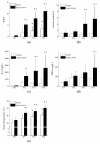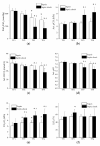SOFA Score, Hemodynamics and Body Temperature Allow Early Discrimination between Porcine Peritonitis-Induced Sepsis and Peritonitis-Induced Septic Shock
- PMID: 33670874
- PMCID: PMC7997134
- DOI: 10.3390/jpm11030164
SOFA Score, Hemodynamics and Body Temperature Allow Early Discrimination between Porcine Peritonitis-Induced Sepsis and Peritonitis-Induced Septic Shock
Abstract
Porcine model of peritonitis-induced sepsis is a well-established clinically relevant model of human disease. Interindividual variability of the response often complicates the interpretation of findings. To better understand the biological basis of the disease variability, the progression of the disease was compared between animals with sepsis and septic shock. Peritonitis was induced by inoculation of autologous feces in fifteen anesthetized, mechanically ventilated and surgically instrumented pigs and continued for 24 h. Cardiovascular and biochemical parameters were collected at baseline (just before peritonitis induction), 12 h, 18 h and 24 h (end of the experiment) after induction of peritonitis. Analysis of multiple parameters revealed the earliest significant differences between sepsis and septic shock groups in the sequential organ failure assessment (SOFA) score, systemic vascular resistance, partial pressure of oxygen in mixed venous blood and body temperature. Other significant functional differences developed later in the course of the disease. The data indicate that SOFA score, hemodynamical parameters and body temperature discriminate early between sepsis and septic shock in a clinically relevant porcine model. Early pronounced alterations of these parameters may herald a progression of the disease toward irreversible septic shock.
Keywords: SOFA score; pig; sepsis; septic shock.
Conflict of interest statement
The authors declare no conflict of interest.
Figures




References
-
- E Rudd K., Johnson S.C., Agesa K.M., Shackelford K.A., Tsoi D., Kievlan D.R., Colombara D.V., Ikuta K.S., Kissoon N., Finfer S., et al. Global, regional, and national sepsis incidence and mortality, 1990–2017: Analysis for the Global Burden of Disease Study. Lancet. 2020;395:200–211. doi: 10.1016/S0140-6736(19)32989-7. - DOI - PMC - PubMed
-
- Fleischmann M.C., Scherag A., Adhikari N.K.J., Hartog C.S., Tsaganos T., Schlattmann P., Angus D.C., Reinhart K. Assessment of Global Incidence and Mortality of Hospital-treated Sepsis. Current Estimates and Limitations. Am. J. Respir. Crit. Care Med. 2016;193:259–272. doi: 10.1164/rccm.201504-0781OC. - DOI - PubMed
Grants and funding
LinkOut - more resources
Full Text Sources
Other Literature Sources

